Review of Electrical Power System Reliability in Qatar's Climate
VerifiedAdded on 2023/06/12
|7
|1767
|488
Report
AI Summary
This report examines the stability and quality of the electrical power system in Qatar, focusing on the impact of the country's harsh environmental conditions. It details the challenges posed by high temperatures, humidity, sandstorms, and pollution on power transmission networks. The report discusses the failures experienced in the 1990s due to low-quality insulators and the subsequent adoption of preventive measures, including the use of aerodynamic insulators, increased creepage distances, and rigorous maintenance programs. It also explores the implementation of live line washing and infra-red thermography inspection to mitigate pollution-related flashover problems, particularly in coastal and industrial areas. The study concludes by emphasizing the importance of continuous monitoring and advanced technologies to ensure the reliability and availability of Qatar's overhead transmission line system.
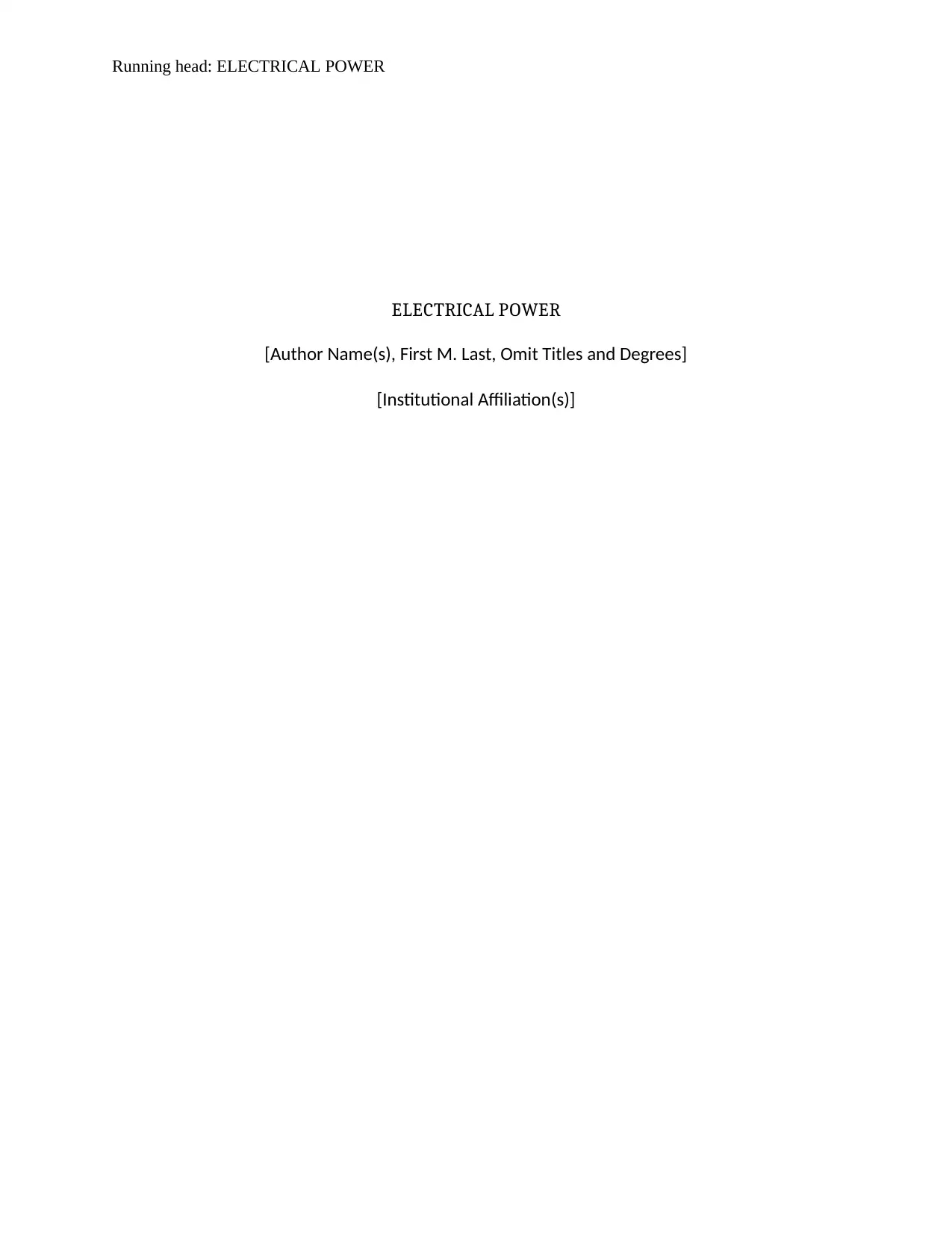
Running head: ELECTRICAL POWER
ELECTRICAL POWER
[Author Name(s), First M. Last, Omit Titles and Degrees]
[Institutional Affiliation(s)]
ELECTRICAL POWER
[Author Name(s), First M. Last, Omit Titles and Degrees]
[Institutional Affiliation(s)]
Paraphrase This Document
Need a fresh take? Get an instant paraphrase of this document with our AI Paraphraser
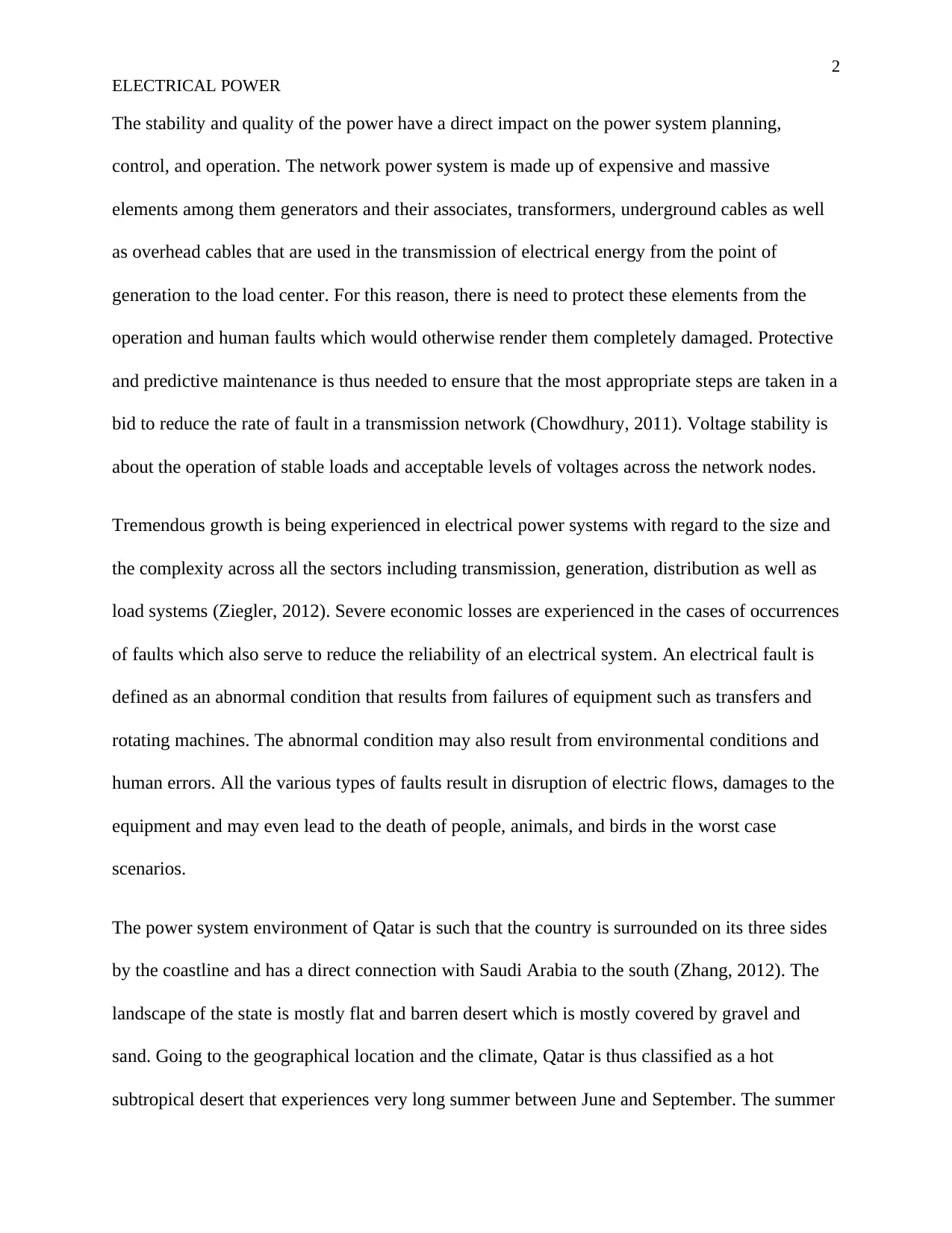
2
ELECTRICAL POWER
The stability and quality of the power have a direct impact on the power system planning,
control, and operation. The network power system is made up of expensive and massive
elements among them generators and their associates, transformers, underground cables as well
as overhead cables that are used in the transmission of electrical energy from the point of
generation to the load center. For this reason, there is need to protect these elements from the
operation and human faults which would otherwise render them completely damaged. Protective
and predictive maintenance is thus needed to ensure that the most appropriate steps are taken in a
bid to reduce the rate of fault in a transmission network (Chowdhury, 2011). Voltage stability is
about the operation of stable loads and acceptable levels of voltages across the network nodes.
Tremendous growth is being experienced in electrical power systems with regard to the size and
the complexity across all the sectors including transmission, generation, distribution as well as
load systems (Ziegler, 2012). Severe economic losses are experienced in the cases of occurrences
of faults which also serve to reduce the reliability of an electrical system. An electrical fault is
defined as an abnormal condition that results from failures of equipment such as transfers and
rotating machines. The abnormal condition may also result from environmental conditions and
human errors. All the various types of faults result in disruption of electric flows, damages to the
equipment and may even lead to the death of people, animals, and birds in the worst case
scenarios.
The power system environment of Qatar is such that the country is surrounded on its three sides
by the coastline and has a direct connection with Saudi Arabia to the south (Zhang, 2012). The
landscape of the state is mostly flat and barren desert which is mostly covered by gravel and
sand. Going to the geographical location and the climate, Qatar is thus classified as a hot
subtropical desert that experiences very long summer between June and September. The summer
ELECTRICAL POWER
The stability and quality of the power have a direct impact on the power system planning,
control, and operation. The network power system is made up of expensive and massive
elements among them generators and their associates, transformers, underground cables as well
as overhead cables that are used in the transmission of electrical energy from the point of
generation to the load center. For this reason, there is need to protect these elements from the
operation and human faults which would otherwise render them completely damaged. Protective
and predictive maintenance is thus needed to ensure that the most appropriate steps are taken in a
bid to reduce the rate of fault in a transmission network (Chowdhury, 2011). Voltage stability is
about the operation of stable loads and acceptable levels of voltages across the network nodes.
Tremendous growth is being experienced in electrical power systems with regard to the size and
the complexity across all the sectors including transmission, generation, distribution as well as
load systems (Ziegler, 2012). Severe economic losses are experienced in the cases of occurrences
of faults which also serve to reduce the reliability of an electrical system. An electrical fault is
defined as an abnormal condition that results from failures of equipment such as transfers and
rotating machines. The abnormal condition may also result from environmental conditions and
human errors. All the various types of faults result in disruption of electric flows, damages to the
equipment and may even lead to the death of people, animals, and birds in the worst case
scenarios.
The power system environment of Qatar is such that the country is surrounded on its three sides
by the coastline and has a direct connection with Saudi Arabia to the south (Zhang, 2012). The
landscape of the state is mostly flat and barren desert which is mostly covered by gravel and
sand. Going to the geographical location and the climate, Qatar is thus classified as a hot
subtropical desert that experiences very long summer between June and September. The summer
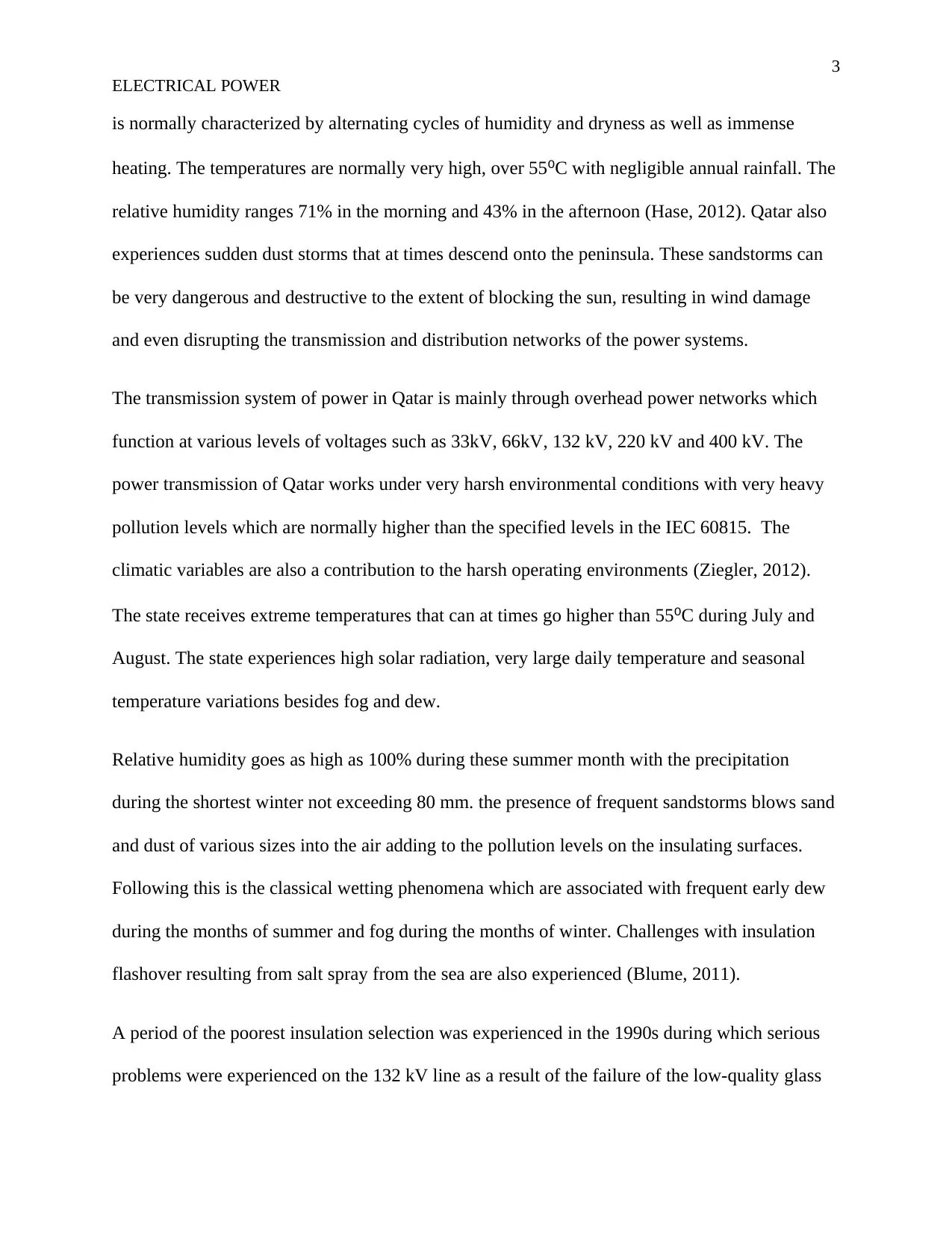
3
ELECTRICAL POWER
is normally characterized by alternating cycles of humidity and dryness as well as immense
heating. The temperatures are normally very high, over 55⁰C with negligible annual rainfall. The
relative humidity ranges 71% in the morning and 43% in the afternoon (Hase, 2012). Qatar also
experiences sudden dust storms that at times descend onto the peninsula. These sandstorms can
be very dangerous and destructive to the extent of blocking the sun, resulting in wind damage
and even disrupting the transmission and distribution networks of the power systems.
The transmission system of power in Qatar is mainly through overhead power networks which
function at various levels of voltages such as 33kV, 66kV, 132 kV, 220 kV and 400 kV. The
power transmission of Qatar works under very harsh environmental conditions with very heavy
pollution levels which are normally higher than the specified levels in the IEC 60815. The
climatic variables are also a contribution to the harsh operating environments (Ziegler, 2012).
The state receives extreme temperatures that can at times go higher than 55⁰C during July and
August. The state experiences high solar radiation, very large daily temperature and seasonal
temperature variations besides fog and dew.
Relative humidity goes as high as 100% during these summer month with the precipitation
during the shortest winter not exceeding 80 mm. the presence of frequent sandstorms blows sand
and dust of various sizes into the air adding to the pollution levels on the insulating surfaces.
Following this is the classical wetting phenomena which are associated with frequent early dew
during the months of summer and fog during the months of winter. Challenges with insulation
flashover resulting from salt spray from the sea are also experienced (Blume, 2011).
A period of the poorest insulation selection was experienced in the 1990s during which serious
problems were experienced on the 132 kV line as a result of the failure of the low-quality glass
ELECTRICAL POWER
is normally characterized by alternating cycles of humidity and dryness as well as immense
heating. The temperatures are normally very high, over 55⁰C with negligible annual rainfall. The
relative humidity ranges 71% in the morning and 43% in the afternoon (Hase, 2012). Qatar also
experiences sudden dust storms that at times descend onto the peninsula. These sandstorms can
be very dangerous and destructive to the extent of blocking the sun, resulting in wind damage
and even disrupting the transmission and distribution networks of the power systems.
The transmission system of power in Qatar is mainly through overhead power networks which
function at various levels of voltages such as 33kV, 66kV, 132 kV, 220 kV and 400 kV. The
power transmission of Qatar works under very harsh environmental conditions with very heavy
pollution levels which are normally higher than the specified levels in the IEC 60815. The
climatic variables are also a contribution to the harsh operating environments (Ziegler, 2012).
The state receives extreme temperatures that can at times go higher than 55⁰C during July and
August. The state experiences high solar radiation, very large daily temperature and seasonal
temperature variations besides fog and dew.
Relative humidity goes as high as 100% during these summer month with the precipitation
during the shortest winter not exceeding 80 mm. the presence of frequent sandstorms blows sand
and dust of various sizes into the air adding to the pollution levels on the insulating surfaces.
Following this is the classical wetting phenomena which are associated with frequent early dew
during the months of summer and fog during the months of winter. Challenges with insulation
flashover resulting from salt spray from the sea are also experienced (Blume, 2011).
A period of the poorest insulation selection was experienced in the 1990s during which serious
problems were experienced on the 132 kV line as a result of the failure of the low-quality glass
⊘ This is a preview!⊘
Do you want full access?
Subscribe today to unlock all pages.

Trusted by 1+ million students worldwide
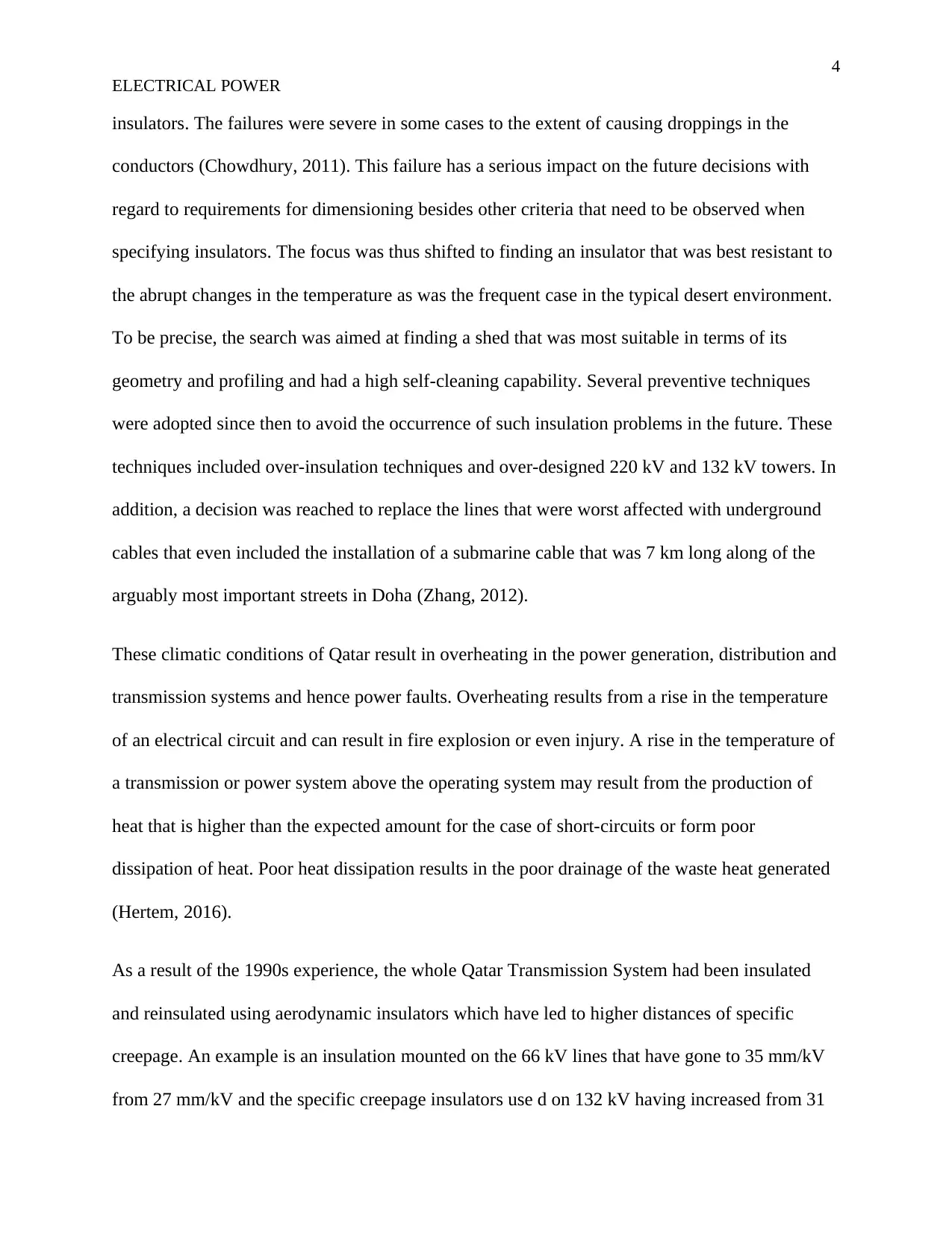
4
ELECTRICAL POWER
insulators. The failures were severe in some cases to the extent of causing droppings in the
conductors (Chowdhury, 2011). This failure has a serious impact on the future decisions with
regard to requirements for dimensioning besides other criteria that need to be observed when
specifying insulators. The focus was thus shifted to finding an insulator that was best resistant to
the abrupt changes in the temperature as was the frequent case in the typical desert environment.
To be precise, the search was aimed at finding a shed that was most suitable in terms of its
geometry and profiling and had a high self-cleaning capability. Several preventive techniques
were adopted since then to avoid the occurrence of such insulation problems in the future. These
techniques included over-insulation techniques and over-designed 220 kV and 132 kV towers. In
addition, a decision was reached to replace the lines that were worst affected with underground
cables that even included the installation of a submarine cable that was 7 km long along of the
arguably most important streets in Doha (Zhang, 2012).
These climatic conditions of Qatar result in overheating in the power generation, distribution and
transmission systems and hence power faults. Overheating results from a rise in the temperature
of an electrical circuit and can result in fire explosion or even injury. A rise in the temperature of
a transmission or power system above the operating system may result from the production of
heat that is higher than the expected amount for the case of short-circuits or form poor
dissipation of heat. Poor heat dissipation results in the poor drainage of the waste heat generated
(Hertem, 2016).
As a result of the 1990s experience, the whole Qatar Transmission System had been insulated
and reinsulated using aerodynamic insulators which have led to higher distances of specific
creepage. An example is an insulation mounted on the 66 kV lines that have gone to 35 mm/kV
from 27 mm/kV and the specific creepage insulators use d on 132 kV having increased from 31
ELECTRICAL POWER
insulators. The failures were severe in some cases to the extent of causing droppings in the
conductors (Chowdhury, 2011). This failure has a serious impact on the future decisions with
regard to requirements for dimensioning besides other criteria that need to be observed when
specifying insulators. The focus was thus shifted to finding an insulator that was best resistant to
the abrupt changes in the temperature as was the frequent case in the typical desert environment.
To be precise, the search was aimed at finding a shed that was most suitable in terms of its
geometry and profiling and had a high self-cleaning capability. Several preventive techniques
were adopted since then to avoid the occurrence of such insulation problems in the future. These
techniques included over-insulation techniques and over-designed 220 kV and 132 kV towers. In
addition, a decision was reached to replace the lines that were worst affected with underground
cables that even included the installation of a submarine cable that was 7 km long along of the
arguably most important streets in Doha (Zhang, 2012).
These climatic conditions of Qatar result in overheating in the power generation, distribution and
transmission systems and hence power faults. Overheating results from a rise in the temperature
of an electrical circuit and can result in fire explosion or even injury. A rise in the temperature of
a transmission or power system above the operating system may result from the production of
heat that is higher than the expected amount for the case of short-circuits or form poor
dissipation of heat. Poor heat dissipation results in the poor drainage of the waste heat generated
(Hertem, 2016).
As a result of the 1990s experience, the whole Qatar Transmission System had been insulated
and reinsulated using aerodynamic insulators which have led to higher distances of specific
creepage. An example is an insulation mounted on the 66 kV lines that have gone to 35 mm/kV
from 27 mm/kV and the specific creepage insulators use d on 132 kV having increased from 31
Paraphrase This Document
Need a fresh take? Get an instant paraphrase of this document with our AI Paraphraser
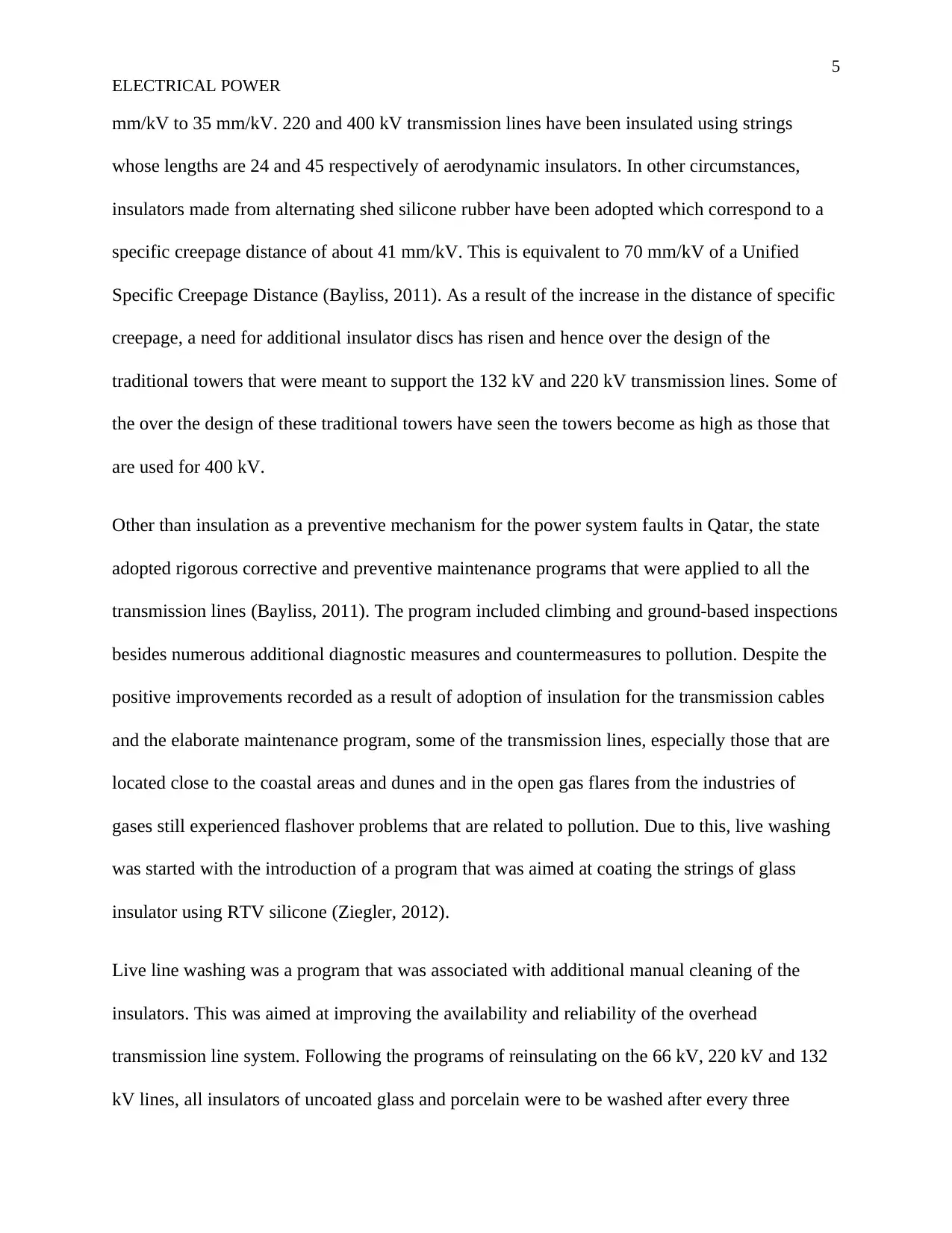
5
ELECTRICAL POWER
mm/kV to 35 mm/kV. 220 and 400 kV transmission lines have been insulated using strings
whose lengths are 24 and 45 respectively of aerodynamic insulators. In other circumstances,
insulators made from alternating shed silicone rubber have been adopted which correspond to a
specific creepage distance of about 41 mm/kV. This is equivalent to 70 mm/kV of a Unified
Specific Creepage Distance (Bayliss, 2011). As a result of the increase in the distance of specific
creepage, a need for additional insulator discs has risen and hence over the design of the
traditional towers that were meant to support the 132 kV and 220 kV transmission lines. Some of
the over the design of these traditional towers have seen the towers become as high as those that
are used for 400 kV.
Other than insulation as a preventive mechanism for the power system faults in Qatar, the state
adopted rigorous corrective and preventive maintenance programs that were applied to all the
transmission lines (Bayliss, 2011). The program included climbing and ground-based inspections
besides numerous additional diagnostic measures and countermeasures to pollution. Despite the
positive improvements recorded as a result of adoption of insulation for the transmission cables
and the elaborate maintenance program, some of the transmission lines, especially those that are
located close to the coastal areas and dunes and in the open gas flares from the industries of
gases still experienced flashover problems that are related to pollution. Due to this, live washing
was started with the introduction of a program that was aimed at coating the strings of glass
insulator using RTV silicone (Ziegler, 2012).
Live line washing was a program that was associated with additional manual cleaning of the
insulators. This was aimed at improving the availability and reliability of the overhead
transmission line system. Following the programs of reinsulating on the 66 kV, 220 kV and 132
kV lines, all insulators of uncoated glass and porcelain were to be washed after every three
ELECTRICAL POWER
mm/kV to 35 mm/kV. 220 and 400 kV transmission lines have been insulated using strings
whose lengths are 24 and 45 respectively of aerodynamic insulators. In other circumstances,
insulators made from alternating shed silicone rubber have been adopted which correspond to a
specific creepage distance of about 41 mm/kV. This is equivalent to 70 mm/kV of a Unified
Specific Creepage Distance (Bayliss, 2011). As a result of the increase in the distance of specific
creepage, a need for additional insulator discs has risen and hence over the design of the
traditional towers that were meant to support the 132 kV and 220 kV transmission lines. Some of
the over the design of these traditional towers have seen the towers become as high as those that
are used for 400 kV.
Other than insulation as a preventive mechanism for the power system faults in Qatar, the state
adopted rigorous corrective and preventive maintenance programs that were applied to all the
transmission lines (Bayliss, 2011). The program included climbing and ground-based inspections
besides numerous additional diagnostic measures and countermeasures to pollution. Despite the
positive improvements recorded as a result of adoption of insulation for the transmission cables
and the elaborate maintenance program, some of the transmission lines, especially those that are
located close to the coastal areas and dunes and in the open gas flares from the industries of
gases still experienced flashover problems that are related to pollution. Due to this, live washing
was started with the introduction of a program that was aimed at coating the strings of glass
insulator using RTV silicone (Ziegler, 2012).
Live line washing was a program that was associated with additional manual cleaning of the
insulators. This was aimed at improving the availability and reliability of the overhead
transmission line system. Following the programs of reinsulating on the 66 kV, 220 kV and 132
kV lines, all insulators of uncoated glass and porcelain were to be washed after every three
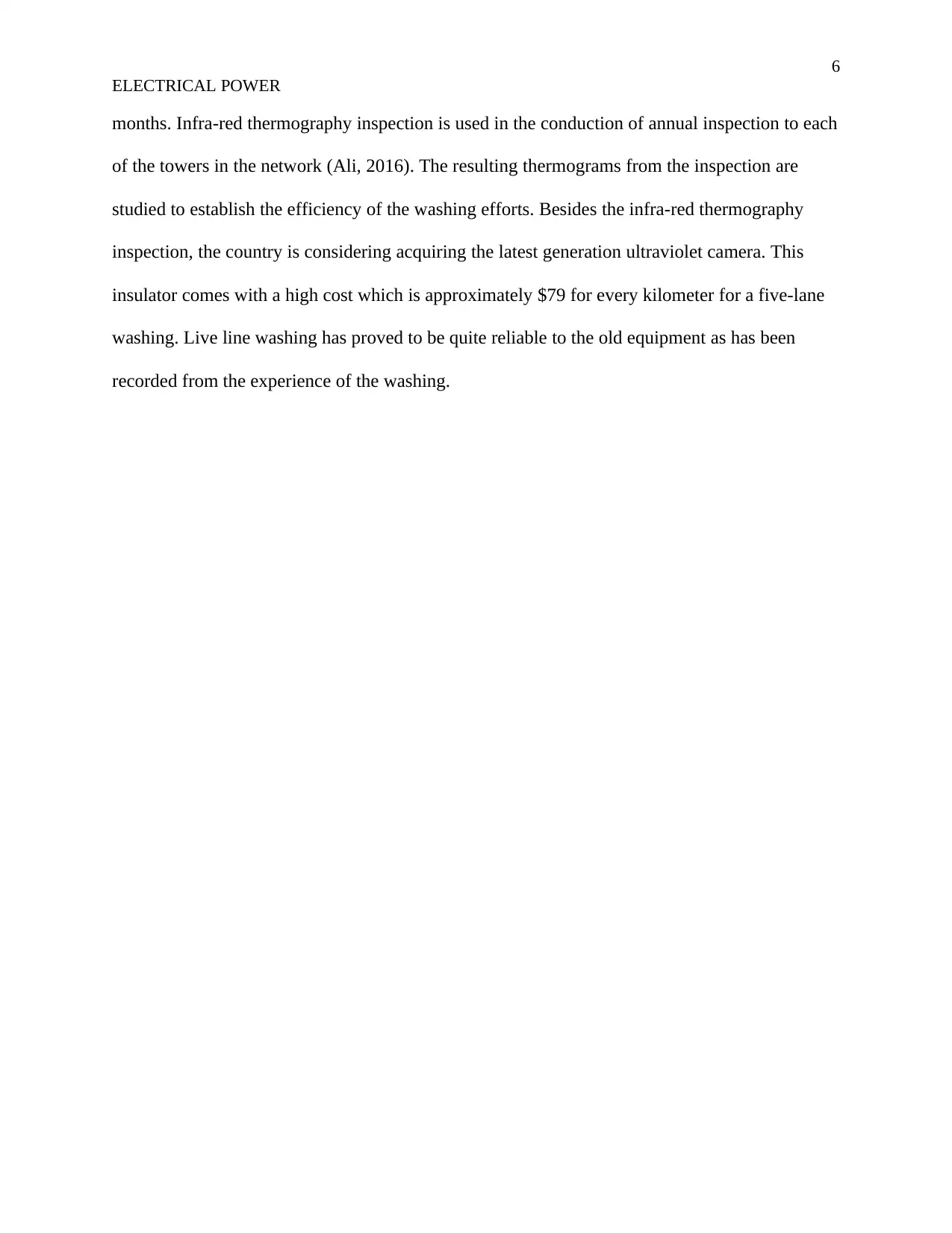
6
ELECTRICAL POWER
months. Infra-red thermography inspection is used in the conduction of annual inspection to each
of the towers in the network (Ali, 2016). The resulting thermograms from the inspection are
studied to establish the efficiency of the washing efforts. Besides the infra-red thermography
inspection, the country is considering acquiring the latest generation ultraviolet camera. This
insulator comes with a high cost which is approximately $79 for every kilometer for a five-lane
washing. Live line washing has proved to be quite reliable to the old equipment as has been
recorded from the experience of the washing.
ELECTRICAL POWER
months. Infra-red thermography inspection is used in the conduction of annual inspection to each
of the towers in the network (Ali, 2016). The resulting thermograms from the inspection are
studied to establish the efficiency of the washing efforts. Besides the infra-red thermography
inspection, the country is considering acquiring the latest generation ultraviolet camera. This
insulator comes with a high cost which is approximately $79 for every kilometer for a five-lane
washing. Live line washing has proved to be quite reliable to the old equipment as has been
recorded from the experience of the washing.
⊘ This is a preview!⊘
Do you want full access?
Subscribe today to unlock all pages.

Trusted by 1+ million students worldwide
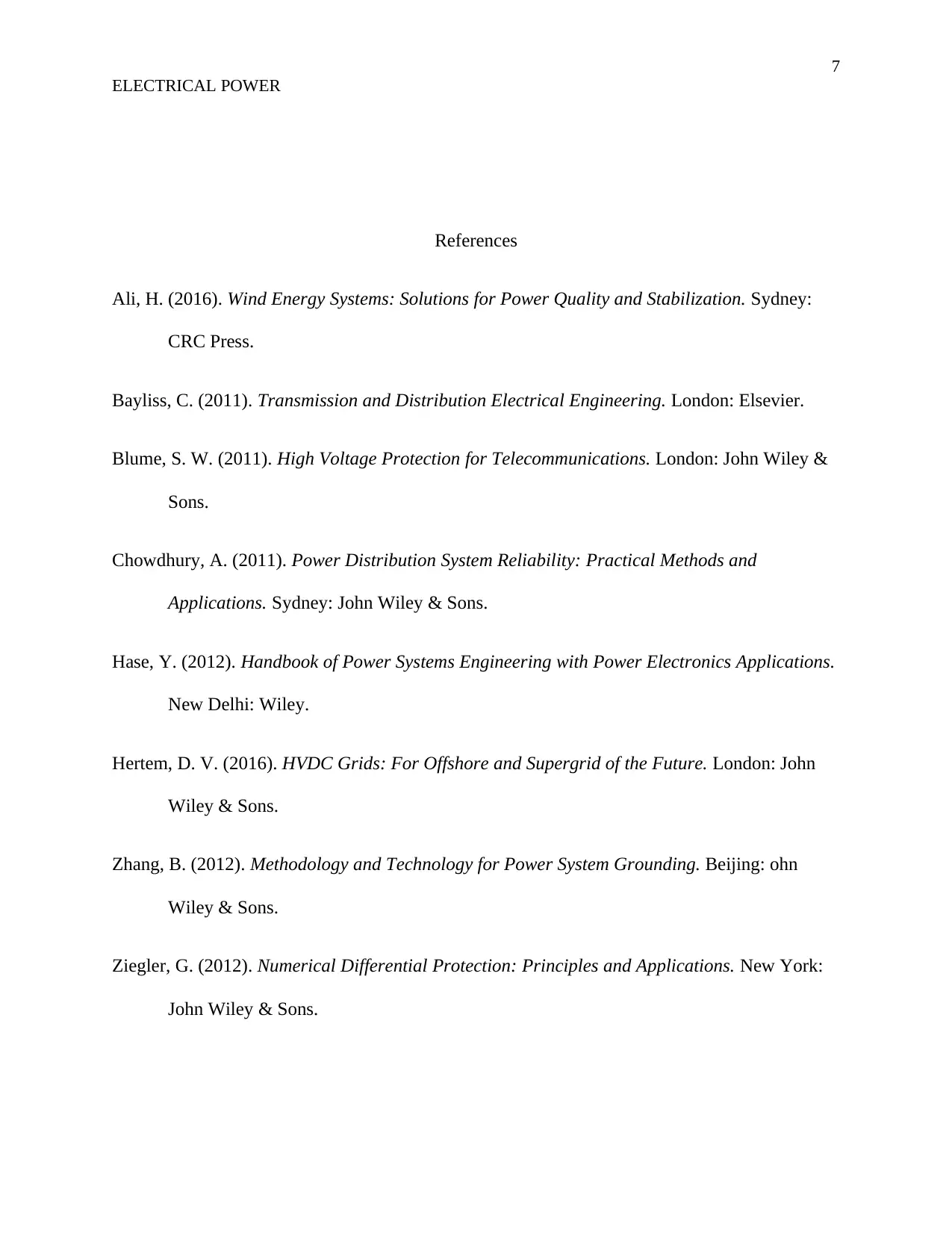
7
ELECTRICAL POWER
References
Ali, H. (2016). Wind Energy Systems: Solutions for Power Quality and Stabilization. Sydney:
CRC Press.
Bayliss, C. (2011). Transmission and Distribution Electrical Engineering. London: Elsevier.
Blume, S. W. (2011). High Voltage Protection for Telecommunications. London: John Wiley &
Sons.
Chowdhury, A. (2011). Power Distribution System Reliability: Practical Methods and
Applications. Sydney: John Wiley & Sons.
Hase, Y. (2012). Handbook of Power Systems Engineering with Power Electronics Applications.
New Delhi: Wiley.
Hertem, D. V. (2016). HVDC Grids: For Offshore and Supergrid of the Future. London: John
Wiley & Sons.
Zhang, B. (2012). Methodology and Technology for Power System Grounding. Beijing: ohn
Wiley & Sons.
Ziegler, G. (2012). Numerical Differential Protection: Principles and Applications. New York:
John Wiley & Sons.
ELECTRICAL POWER
References
Ali, H. (2016). Wind Energy Systems: Solutions for Power Quality and Stabilization. Sydney:
CRC Press.
Bayliss, C. (2011). Transmission and Distribution Electrical Engineering. London: Elsevier.
Blume, S. W. (2011). High Voltage Protection for Telecommunications. London: John Wiley &
Sons.
Chowdhury, A. (2011). Power Distribution System Reliability: Practical Methods and
Applications. Sydney: John Wiley & Sons.
Hase, Y. (2012). Handbook of Power Systems Engineering with Power Electronics Applications.
New Delhi: Wiley.
Hertem, D. V. (2016). HVDC Grids: For Offshore and Supergrid of the Future. London: John
Wiley & Sons.
Zhang, B. (2012). Methodology and Technology for Power System Grounding. Beijing: ohn
Wiley & Sons.
Ziegler, G. (2012). Numerical Differential Protection: Principles and Applications. New York:
John Wiley & Sons.
1 out of 7
Related Documents
Your All-in-One AI-Powered Toolkit for Academic Success.
+13062052269
info@desklib.com
Available 24*7 on WhatsApp / Email
![[object Object]](/_next/static/media/star-bottom.7253800d.svg)
Unlock your academic potential
Copyright © 2020–2025 A2Z Services. All Rights Reserved. Developed and managed by ZUCOL.





